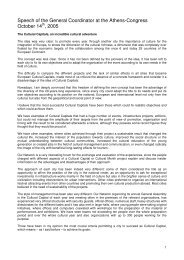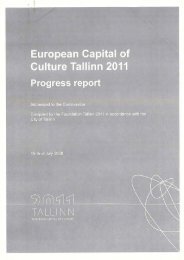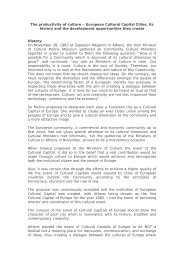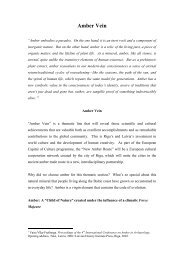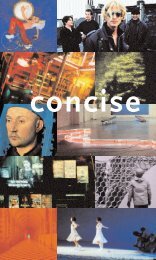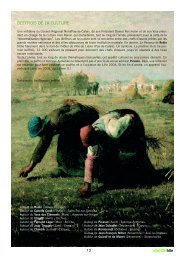patras 2006 - Documentation Centre on European Capitals of ...
patras 2006 - Documentation Centre on European Capitals of ...
patras 2006 - Documentation Centre on European Capitals of ...
You also want an ePaper? Increase the reach of your titles
YUMPU automatically turns print PDFs into web optimized ePapers that Google loves.
Hexag<strong>on</strong>eHexag<strong>on</strong>eΠΟΙΗΣΗ ΤΗΣ ΜΟΥΣΙΚΗΣ ΤΟΥ 20ού ΑΙΩΝΑHexag<strong>on</strong>eΣυναυλία µε χρήση οπτικών µέσων και υψηλή τεχνολογίαΙάννης Ξενάκης: Ψάπφα (1975), Περσέφασσα (1969)14 Mαΐου <str<strong>on</strong>g>2006</str<strong>on</strong>g> Παλαιό Αρσάκειο∆ηµήτρης ∆εσύλλας, κρουστάΆγης Γυφτόπουλος, ηχητικός σχεδιασµόςΨάπφα«Μετά από πολλές παραστάσεις των έργων του Ιάννη Ξενάκη “Psappha” και “Reb<strong>on</strong>ds”, αισθανόµουν την ανάγκηνα κάνω αυτή την ηχογράφηση-παράσταση, ώστε να δώσω τη δική µου οπτική γι’ αυτό το µεγάλο έργο.Αναφορικά µε την “Persephassa” τα πάντα έχουν να κάνουν µε την ακρίβεια.».∆ηµήτρης ∆εσύλλας«Από την οπτική γωνία της ηχογράφησης ήταν φανερό ότι έπρεπε να δοθεί προτεραιότητα στο να είναι ο ήχος µία τρισδιάστατη απεικόνισητου πραγµατικού στησίµατος των οργάνων, καθώς και στη διατήρηση των αρµονικών, των ηχοχρωµάτων και των δυναµικών.Πολύ περισσότερο να υποστηριχθεί η ακρίβεια και η καθαρότητα της εκτέλεσης του κρουστού, έτσι ώστε να καταφέρουµε τελικάνα αποδοθούν σε όλο τους το φάσµα το έργο του Ιάννη Ξενάκη και η εκτέλεση του ∆ηµήτρη ∆εσύλλα.».Άγης ΓυφτόπουλοςΓραµµένο το 1975 για έναν εκτελεστή κρουστών, η Ψάπφαείναι ίσως το έργο µε τις περισσότερες ζωντανές εκτελέσειςτου Ιάννη Ξενάκη και ένα από τα κορυφαία κοµµάτια τηςεργογραφίας της δυτικής µουσικής για τα κρουστά όργανα.Με την Ψάπφα, αιολικό τύπο του ονόµατος Σαπφώ,ο Ξενάκης αποτίει φόρο τιµής στη µεγάλη ποιήτρια τηςαρχαιότητας από τη Λέσβο, η οποία είχε καινοτοµήσει20TH CENTURY MUSIC POETRYHexag<strong>on</strong>eC<strong>on</strong>cert with hi-end audio and visual presentati<strong>on</strong>Iannis Xenakis: Psappha (1975), Persephassa (1969)May 14, <str<strong>on</strong>g>2006</str<strong>on</strong>g> Old Arsakeio Collegeστη λυρική ποίηση εισάγοντας καινούρια ποιητικά µέτρα.Οι ρυθµικές δοµές της Ψάπφας προέρχονται από ταχαρακτηριστικά ρυθµικά κύτταρα της σαπφικής ποίησης,τα οποία, υποκείµενα σε ποικίλες µεταθέσεις, διατρέχουν όλοτο έργο. Σε ό,τι αφορά την επιλογή των οργάνων πουδύνανται να χρησιµοποιηθούν για την εκτέλεση του έργου,ο συνθέτης αφήνει µεγάλη ελευθερία στον εκτελεστή, καθώς,σύµφωνα µε τον ίδιο, το «ηχόχρωµα έχει δευτερεύοντα ρόλοστο έργο και χρησιµεύει µόνο για να καταστήσει σαφέστερεςτις ρυθµικές δοµές». Η Ψάπφα είναι αφιερωµένη στο SylvioGualda, o οποίος και την ερµήνευσε για πρώτη φορά στο“After many performances <strong>of</strong> the compositi<strong>on</strong>s <strong>of</strong> Iannis Xenakis, “Psappha” and “Reb<strong>on</strong>ds”,I felt the need to do this recording-performance to mark my perspective <strong>on</strong> this great work.Regarding “Persephassa”, everything has to do with precisi<strong>on</strong>”.Dimitris Desyllas5455“From the viewpoint <strong>of</strong> the recording, it was obvious that priority had to be given so the sound portrayed a three-dimensi<strong>on</strong>alimaging <strong>of</strong> the actual instrumental setup, while maintaining harm<strong>on</strong>ics, timbres and dynamics.Furthermore, the precisi<strong>on</strong> and clearness <strong>of</strong> the percussi<strong>on</strong>s must be supported, so that we may succeed in renderingthe entire spectrum <strong>of</strong> Iannis Xenakis’ work and Dimitris Desyllas’ performance”.Agis GyphtopoulosDimitris Desyllas, percussi<strong>on</strong>sAgis Gyphtopoulos, sound designPsapphaWritten in 1975 for percussi<strong>on</strong>s, Psappha is perhapsIannis Xenakis’ compositi<strong>on</strong> with the most liveperformances and <strong>on</strong>e <strong>of</strong> the leading compositi<strong>on</strong>sfor percussi<strong>on</strong>s <strong>of</strong> Western music.With Psappha,the aeolian name for Sappho, Xenakis h<strong>on</strong>ours the greatancient poetess from the island <strong>of</strong> Lesvos, who pi<strong>on</strong>eeredin lyric poetry by introducing novel poetic metres.The rhythmic structures <strong>of</strong> Psappha derive from smallrhythmic cells characteristic <strong>of</strong> Sapphic poetry.These rhythms are subjected to various permutati<strong>on</strong>sand pervade the entire work.With regard to choice<strong>of</strong> the instruments used to perform the work, thecomposer lets the performer decide, since accordingto the composer himself, “timbre plays a subordinate rolein the compositi<strong>on</strong> and is used <strong>on</strong>ly to provide clarityto the rhythmic structures”. Psappha is dedicated



